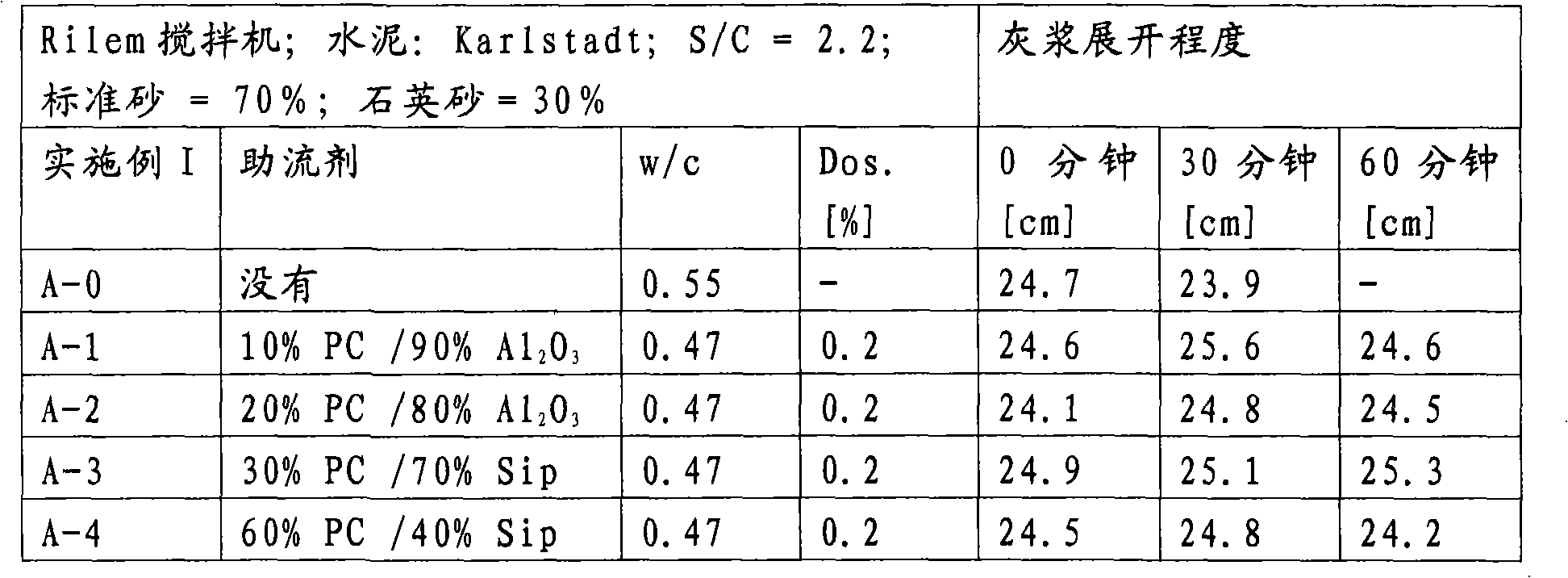Pulverulent polycondensation products
A polycondensation product, powdery technology, applied in the field of powder polycondensation products, can solve the problems of the influence of polymer activity, failure to achieve high degree of polymerization, high cost, etc.
- Summary
- Abstract
- Description
- Claims
- Application Information
AI Technical Summary
Problems solved by technology
Method used
Image
Examples
Embodiment A-1
[0046] 1mol of poly(ethylene oxide) monophenyl ether (2000g / mol), 1mol of phenoxyethanol phosphate (or 2-phenoxyethanol dihydrogen phosphate and 2-phenoxyethanol hydrogen phosphate mixture), 0.6mol water and 2mol concentrated H 2 SO 4 Add with stirring. To the solution thus formed was added dropwise 2 mol of formaldehyde in the form of a 37% aqueous solution. The polycondensation reaction was completed at 105°C over a period of 5 hours. After the reaction, without pre-neutralization, basic alumina (particle size 0.05-0.15mm) was slowly stirred into the liquid polymer melt at about 80°C until a soft powder was formed. The amount of aluminum oxide was selected such that the proportion of the polycondensation product on the support was 10% by weight.
Embodiment A-2
[0048] 1mol of poly(ethylene oxide) monophenyl ether (2000g / mol), 1mol of phenoxyethanol phosphate (or 2-phenoxyethanol dihydrogen phosphate and 2-phenoxyethanol hydrogen phosphate mixture), 0.6mol water and 2mol concentrated H 2 SO 4 Mix under stirring. To the solution thus formed was added dropwise 2 mol of formaldehyde in the form of a 37% aqueous solution. The polycondensation reaction was completed at 105°C over a period of 5 hours. After the reaction, without pre-neutralization, basic alumina (particle size 0.05-0.15mm) was slowly stirred into the liquid polymer melt at about 80°C until a soft powder was formed. The amount of aluminum oxide was selected such that the proportion of the polycondensation product on the support was 20% by weight.
Embodiment A-3
[0050] 1mol of poly(ethylene oxide) monophenyl ether (2000g / mol), 1mol of phenoxyethanol phosphate (or 2-phenoxyethanol dihydrogen phosphate and 2-phenoxyethanol hydrogen phosphate mixture), 0.6mol water and 2mol concentrated H 2 SO 4 Mix under stirring. To the solution thus formed was added dropwise 2 mol of formaldehyde in the form of a 37% aqueous solution. The polycondensation reaction was completed at 105°C over a period of 5 hours. After the reaction, without prior neutralization, slowly stir Sipernat into the liquid polymer melt at about 80 °C (precipitated silicic acid, the average particle diameter is 15μm, and the specific surface area is 50m 2 / g), until a soft powder is formed. Select Sipernat like this The amount is such that the share of the polycondensation product on the support is 30% by weight.
PUM
| Property | Measurement | Unit |
|---|---|---|
| specific surface area | aaaaa | aaaaa |
| particle size | aaaaa | aaaaa |
Abstract
Description
Claims
Application Information
 Login to View More
Login to View More - R&D
- Intellectual Property
- Life Sciences
- Materials
- Tech Scout
- Unparalleled Data Quality
- Higher Quality Content
- 60% Fewer Hallucinations
Browse by: Latest US Patents, China's latest patents, Technical Efficacy Thesaurus, Application Domain, Technology Topic, Popular Technical Reports.
© 2025 PatSnap. All rights reserved.Legal|Privacy policy|Modern Slavery Act Transparency Statement|Sitemap|About US| Contact US: help@patsnap.com



